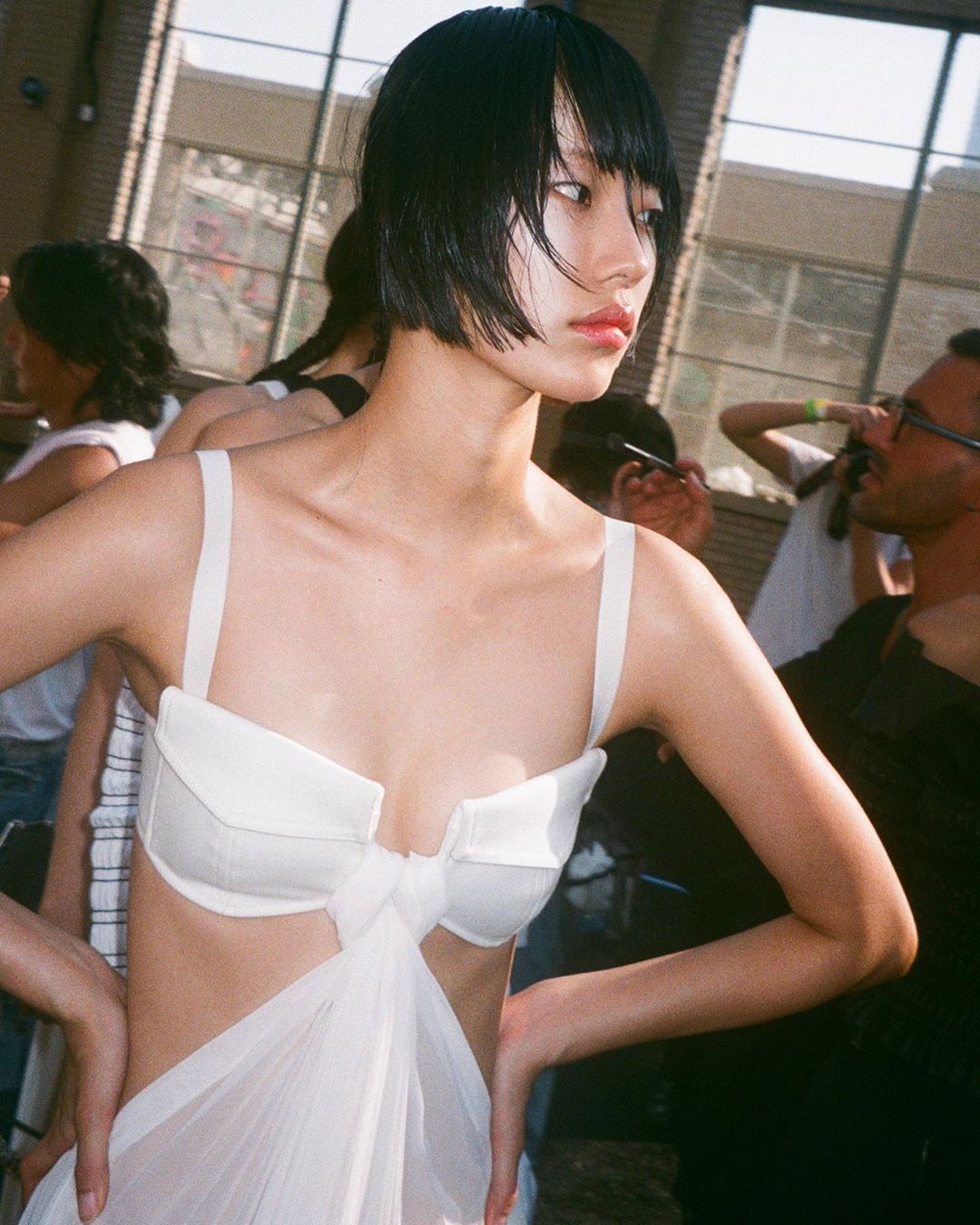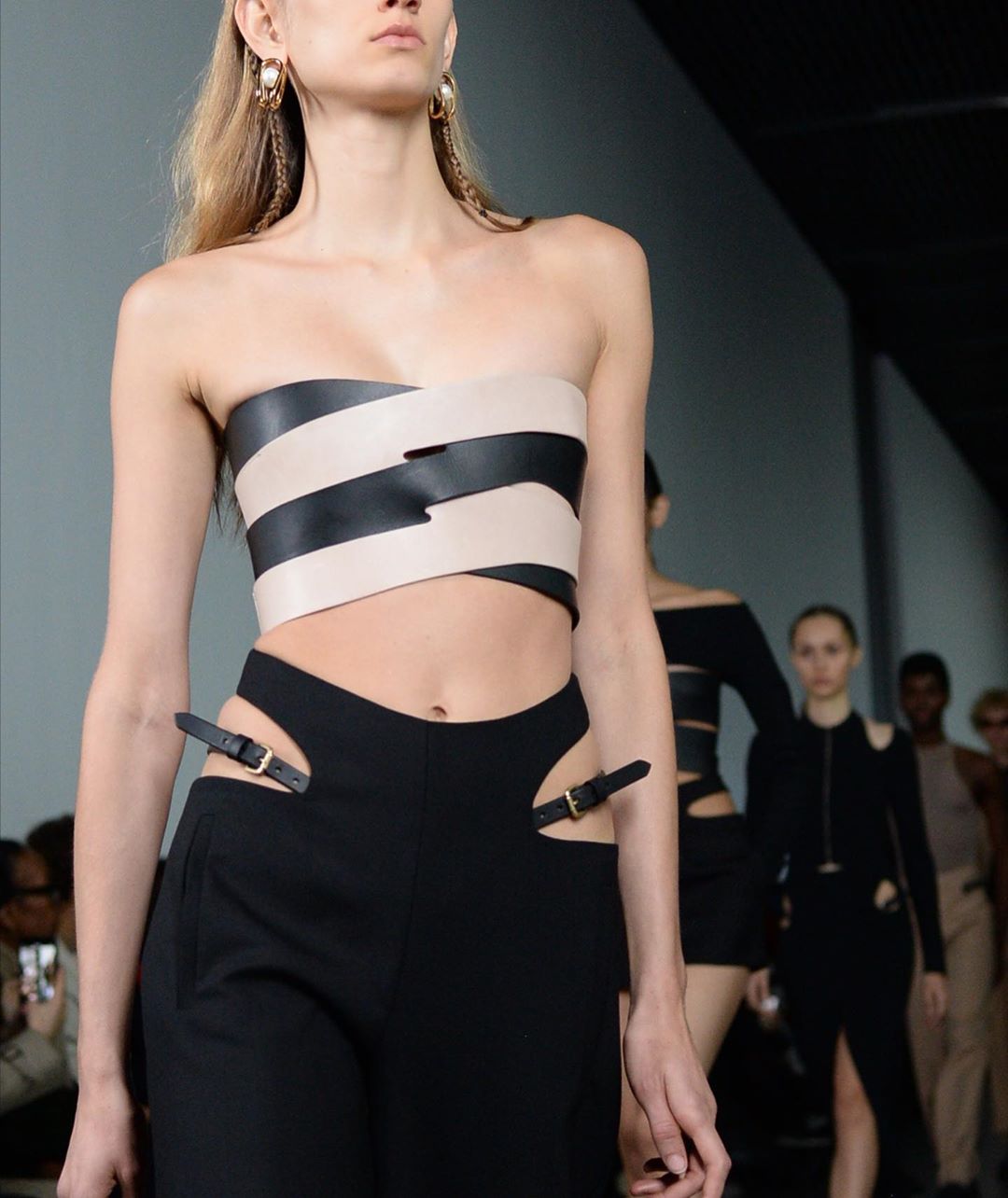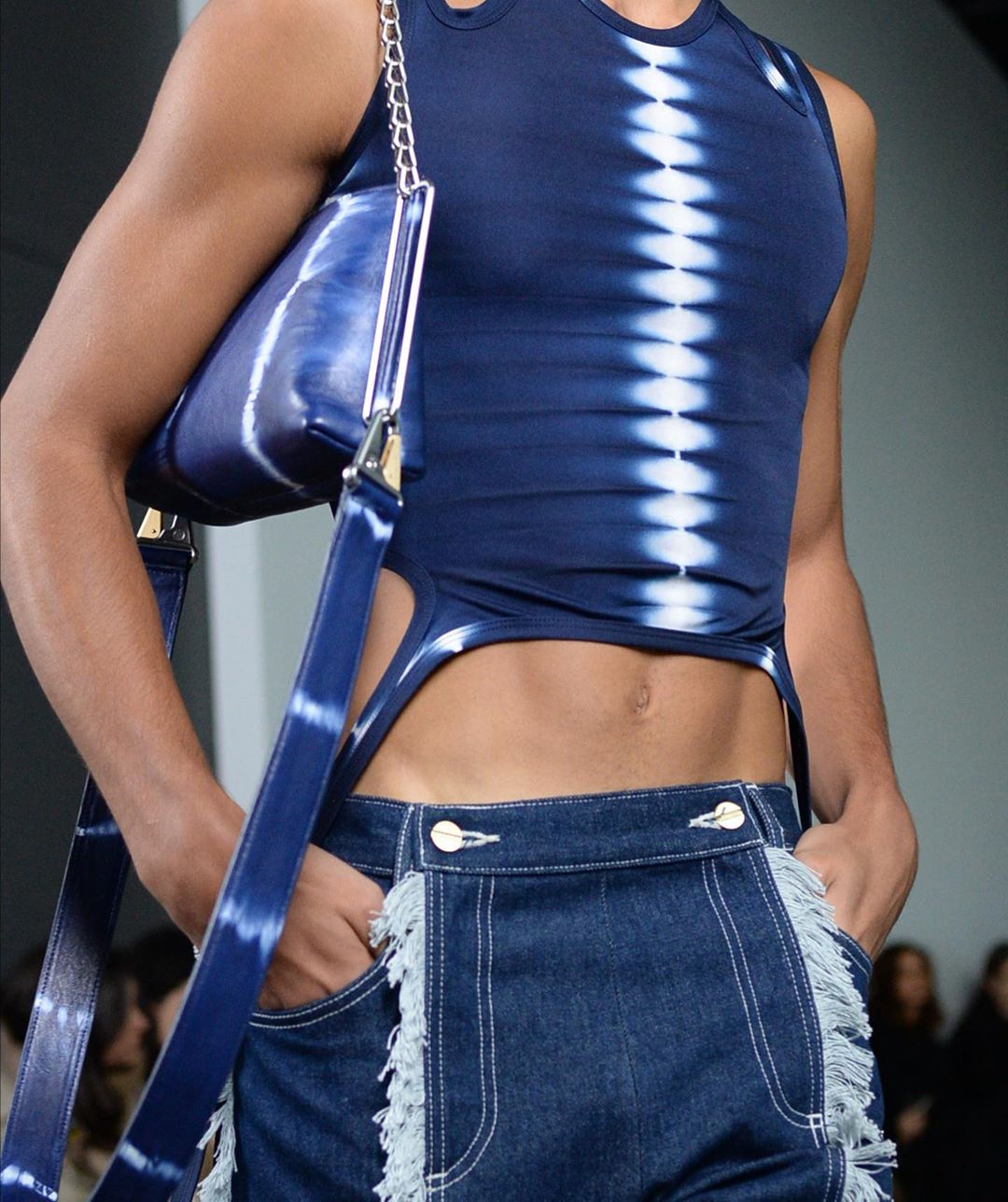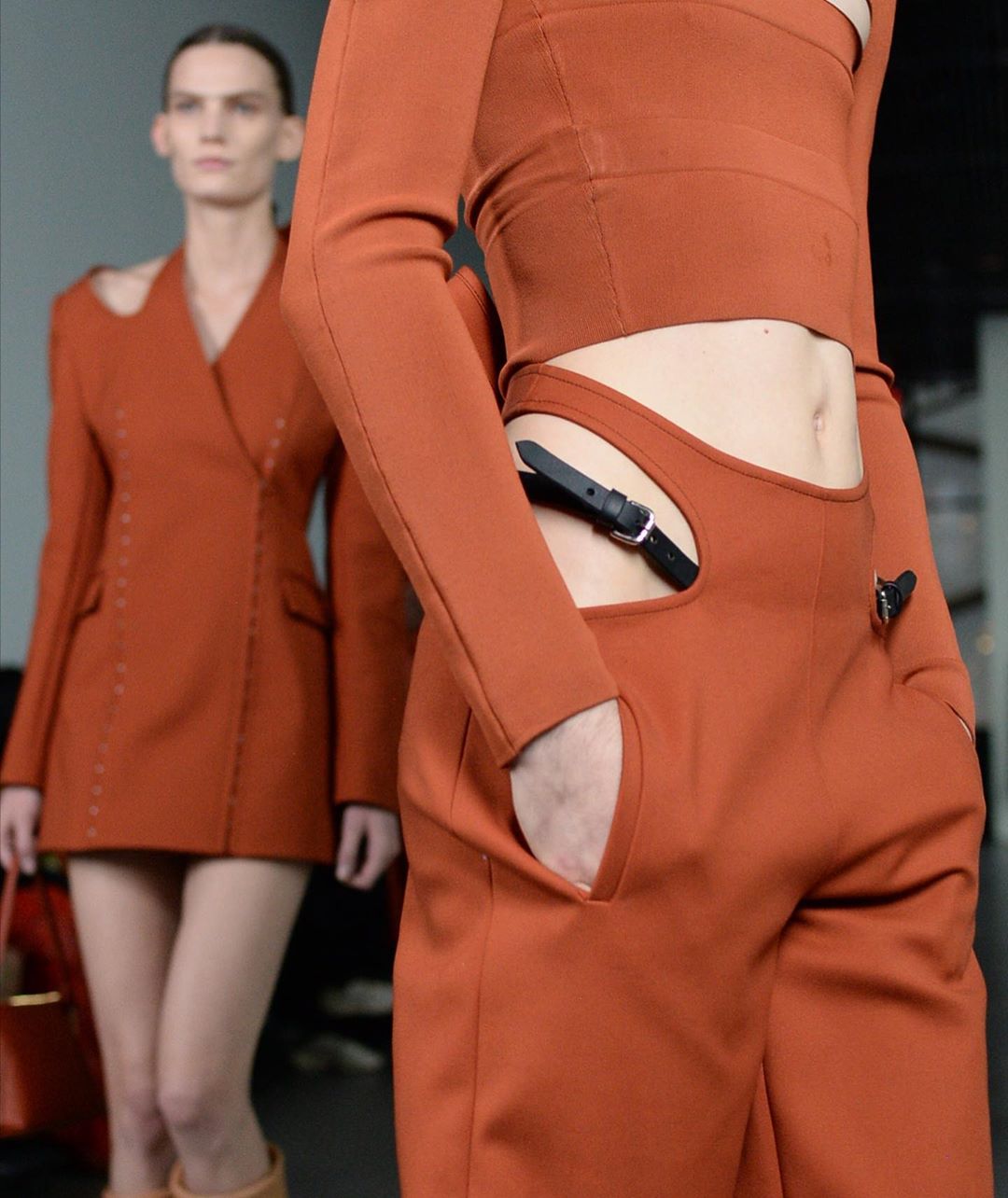
It was 2011 and I’d just bought my first Dion Lee piece. I was studying at university, working part-time and whatever pennies I’d save would go straight into partying and clothes (usually to party in). My debut Dion piece was an A-line mini dress with sheer overlay and matching suede leather belt in a shade of aqua so searing it made my solarium-skin appear an even deeper shade of bronze (it was the noughties – everyone was doing it). My Dion Lee collection continued well into the decade – another mini dress with varying opacity in bright watermelon, a blush crepe skirt, a technical racer-back top, a coral crop with mesh insert and a leather cut-out harness which featured both a matte and high-shine gloss finish, from which I still can’t bear to part.
In retrospect, this wrap-around harness in fact bore the stamp of Lee’s last collection – the elements of fetishwear (with thanks to a collaboration with Fleet Ilya) omnipresent throughout his Spring Summer 2020 show – an intimacy which has been seemingly innate since the start.

On a phone call with the now New York-based Lee, he tells me such themes have been present since the beginning of his career, even as a design student. “All of those elements that really contour the body have been present since my early collections, especially playing with lingerie details and cups,” he says, his voice soft. “It’s very much the idea of using lingerie in an exposed way, using undergarments in an external way.” This consciousness of the female form has been intrinsic in his work from the outset, even his earliest pieces clearly constructed with a woman’s contours in mind.
In spite of this inherent sensuality, Lee’s work has always been tempered with a kind of architectural technicality. It has never presented as overtly outré or showy, rather exists effortlessly, fluidly, even simply, always engineered with a kind of masterful construction. Despite being at the fore of Australian fashion for over a decade, the craftsmanship of his most recent collections caught a very important gaze: that of celebrity. Of course, Lee has long dressed the famous, but there’s a new level of influence and power. Take that corset, for example. It sat in the same category as Bottega Veneta’s square-toe mule or Loewe’s Puzzle Bag: one of the cult, defining pieces of the year that saw almost every celebrity in its soft jersey paneling and dipped hem. It was also a sellout. Over and over and over again, Lee telling me they still can’t keep it in stock. “Celebrity has definitely helped the business on a sale level and in terms of brand awareness,” he explains. “I feel like there are a lot more people now that are aware of the brand and I think that that has really helped us continue to grow.”

But by his own admission, leveraging a brand through celebrity and brand awareness is just “one component” – “it’s really important to have that presence but how you communicate on your own social media platforms is another big part of that.” There’s also another very important component: you have to have an excellent product to start with. I tell him this, and he agrees, almost reluctantly. I also inform him his Spring Summer 2020 collection was my favorite to date (a huge feat for a long-standing fan like myself). “Oh, thank you,” he says beaming, almost bashful. “Hopefully this one will be the same!”

And that it was. Today’s Fall Winter 2020 collection was yet another step-up, with another surprising revelation: jewelry. Not just stand-alone, “show” jewelry (in which he’s dabbled in the past), but jewelry that became the piece, the fusion of jewelry and garment at the collection’s core. “I developed this kind of custom of chain where individual links join onto each other, so that’s really allowed me to both explore jewelry but integrate jewelry into clothes,” he explains. “So a lot of the idea was kind of building these clothes that felt like jewelry and the pieces were like necklaces in a way.”
Indeed, this unique chain-link became the star, not a peripheral accessory; imbuing turtleneck tops, suspending black slacks, dissecting hooded jackets, tracing open backs. Its use was both diverse and deft, adorning athletic silhouettes to feminine pleated mini skirts, moonlighting as waistbands.

A study in both subversion and fluidity, utility and beauty, it felt like the perfect extension of last season, with his famous corsetry, technical approach, and gender neutrality also explored. “There are a lot of elements within the collection that are an evolution from our last Spring Summer collection,” he muses. Even the jewelry began in its infant stages in the previous collection, “really evolving into this collection.”
Inside The Shed, a new cultural space in Hudson Yards in Manhattan’s West Village, models – both male and female – whizzed up escalators in exquisite pieces from this forthcoming collection. While jewelry is a new métier for the designer (he had previously “played with show jewelry” but never in this way), there were other forms of newness. Tie-dye and representations of tribalism came to the fore, although Lee is reticent to describe it this way. “There’s a slightly more, well not exactly tribal, but I guess it is this kind of ‘tribal’ influence that comes into the collection, in terms of how it comes together and how it’s styled, in some of the details and the silhouettes.”
Introducing a “drape and ease that felt really effortless,” indigo-dying techniques were tapped via a textile house in Japan to develop hand-dyed shibori fabrics, which made for a striking new proposition of print. Seeing it unfold almost felt like a really good “trip”, acidic and graphic and spontaneous (and without the hangover).

There was also the 90s – a decade steering fashion as a whole at the moment – that informed the collection. “I was looking at the early 90s and a lot of the trends in music and dance. There’s definitely a feeling of how people were dressing in the early 90s and how that was present in popular culture at the time.”
Once again parlaying subversion through tailoring, hips were exposed in clever, seductive cut-outs as too shoulders, while waists were laced in intricate fishnet (the laser-cut aesthetic has long been a code of the house). Broader concepts of femininity and masculinity were also dismembered; girls were utilitarian, boys were sexy – and together they formed a kind of brilliant non-binary band. Along with his classic muted palette of black, white, grey and khaki,there were a blazing burnt orange and rich indigo rose, as well as a pale salmon.

A quiet achiever, Dion Lee goes about his business softly, gently, but now confidently – something he says has stemmed from New York, his home for the past few years. “It’s definitely a city where you really have to stand your ground, it requires you to be the fullest version of yourself,” he laughs. This newfound confidence is also reflective in his work, his New York-based collections have felt much stronger and subversive in character. “The diversity and the confidence of character that comes from living here does come through in the collection,” he muses. “I think it’s probably that and also evolving as a designer and experiencing new things and surrounding myself with people who inspire me. And continuing to push myself.”

While it’s clear that determination and diligence define Dion Lee, he remains impossibly polite and gracious, almost surprised by his great success.
For the boy who changed Australian fashion, it is so exciting – and well-deserved – to see him take on the world like this.
view the dion lee fall winter 2020 collection below:














